E-commerce has skyrocketed in the last few years. According to statistics, it showed a 16,2% growth in 2021 and 26,7% growth in 2020. As more and more online businesses contend for customers, the competition has become ruthless. As a result, annual spending on e-commerce is booming.
Bringing new visitors to the site is one task but making them convert is another. This article will take a close look at e-commerce SEO best practices for product pages and share vital yet straightforward tips that can help online businesses leverage their websites, improve conversion rates, and boost SEO performance and revenue.
What is Product Page SEO and Why is it Vital?
Let’s find out what a product page is and why it is crucial.
A product page is a page on an e-commerce website that includes the detailed description, specs, and features of a product. It is supposed to familiarize customers with the product and help them make an informed decision to purchase. The product page has a section for reviews and ratings, questions and comments, comparisons with similar products, and payment and shipment information. A product page is where visitors spend most of their time on an e-commerce site.
Nevertheless, some businesses pay too little attention to e-commerce SEO. There are several widespread misconceptions about product pages, so let’s examine them:
| 👎 | 👍 |
|---|---|
| Customers visit the home page, then move on to the required product. So it is more important to improve the home page and catalog sections. | Most customers already know exactly what they want to purchase. So product pages get most of the organic traffic directly from search. Also, sometimes categories and product pages can compete for the same queries and traffic, leading to cannibalization issues. |
| For product pages, it is enough to use product descriptions provided by the manufacturer. | Google prefers unique, high-quality content. Competing for top search positions will be extremely hard if your site uses the same description as others. |
| It is not possible to improve the SEO of every product page on the website. This is incredibly time-consuming. | If you own a small e-commerce site, it is crucial to optimize every single product page. If your site is large and has several sellers, you can develop a set of specific rules, guidelines, and templates to make sure the product pages are optimized. |
Websites focused on improving product pages have higher conversion rates and profits. The ultimate goal of e-commerce product page SEO is to create a page that is user-friendly, optimized for conversions, and accessible to search engines.
Essential Tips for Managing Product Page SEO
Here, we have gathered some detailed information that will help you optimize your product pages for search engines and increase your chances of getting more traffic, conversions, and, eventually, profits.
Make Use of Long-tail Keywords
Let’s start with the basics. The starting point of product page SEO should be selecting your keywords.

You may be looking for high-volume commercial keywords but it is vital to use long-tail queries. They may have lower search volumes but they definitely have higher click-through rates and are excellent for product pages. Use keywords in the page’s title, header tags, meta description, and URL structure.
The most significant advantage of long-tail keywords is that they respond better to buyers' purchase intent. Most of the time, customers know exactly what they are looking for. So the search query is more likely “Nike Air Max 90 sneakers” than “Nike shoes.” Incorporating specific long-tail keywords into the product page will make it easier for search engines to find and show users the most relevant pages, resulting in more traffic and a lower bounce rate on your website.
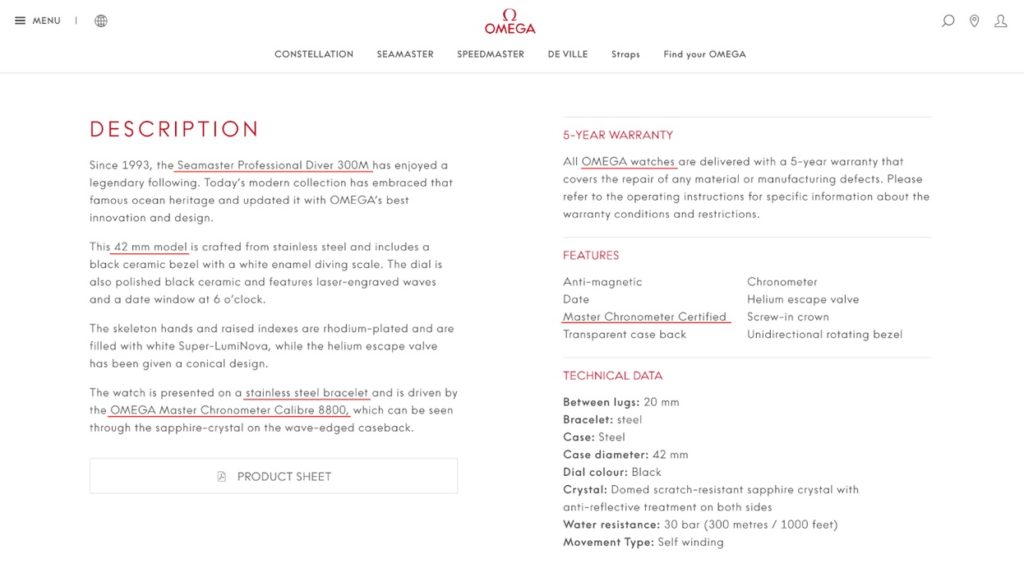
| Tip: For advanced keyword research, try using professional tools like SE Ranking, which will be described later in this article. |
Optimize Titles and Headings
The next important step is optimizing page titles and headings. The title is vital for both SEO and user experience: it impacts how high a product page ranks and defines how it is presented to searchers.
A well-thought-out title is unique, easy to read, and includes product details and the most relevant keywords. But don’t go overboard, as you need to fit it in 600 pixels (approximately 60 characters)—this is the length usually shown in a search snippet. You can include the brand name, model, and related keywords in the title.

| Tip: Think about the title as the first thing customers see when searching for a product. Your goal is to persuade them to click on it, so you want it to be precise and compelling. |
Headings are another page structure element that helps search engines and visitors understand what the page is about and what they can find there.
You will often see duplicated H1 headings and titles. This approach is not recommended and you should avoid using identical texts. Instead, edit them a little bit and add different keywords to distinguish them and make them more user- and SEO-friendly.
H2 headings differentiate page sections: product features, reviews, questions and comments, similar products, etc.
Write Unique Product Descriptions
Creating unique product descriptions can be challenging but it’s worth the effort, especially for small e-commerce websites. If you use generic descriptions provided by the manufacturer, your website won’t be able to compete for the highest-ranking positions. Instead, Google will have to decide between identical texts and will most likely show sites with higher domain trust scores. Therefore, your description should be distinctive and compelling. If you have an enormous website with thousands of pages on it, you might require an automated solution for generating unique product descriptions.
Here’s an example of a well-written product description—it’s unique, persuasive, nicely structured, and provides all the essential information:
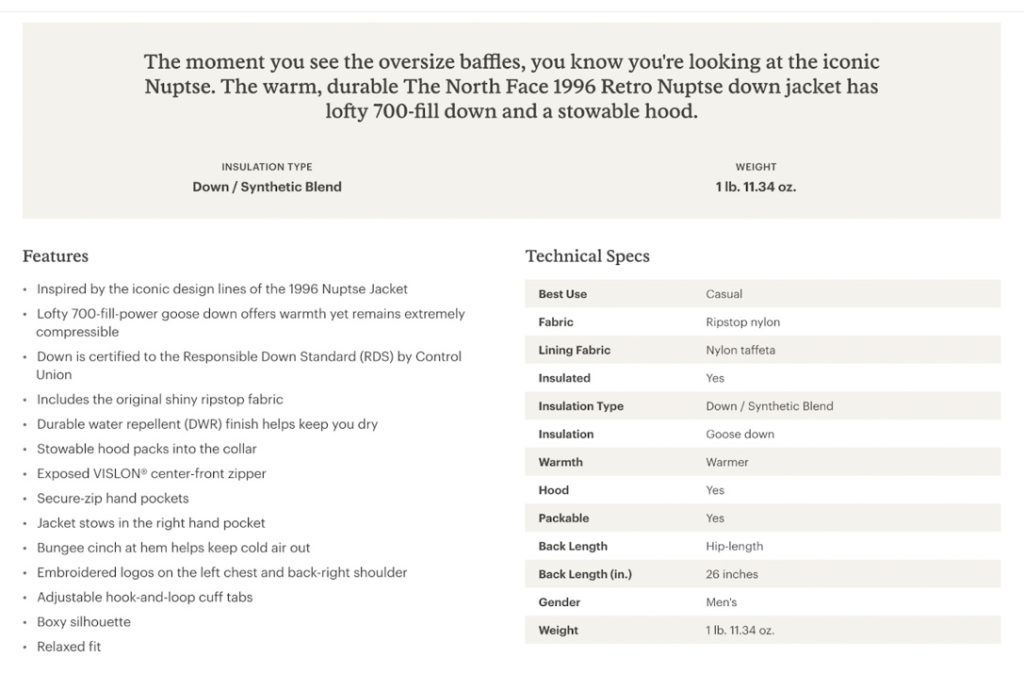
There are no strict requirements for the length of the product description. The product description should be as long as necessary to illustrate product features and provide an overview of the product’s benefits.
| Tip: Display both short and full product descriptions on the page. A brief product overview will help those unfamiliar with the product, while a complete overview will depict all the features. It will be helpful for those who are just one step away from making an order. |
Use Videos and Images
For e-commerce sites, photos and videos are essential. This is the only way potential customers can get a sense of what they are about to purchase.
Always use high-quality images and videos of the product—professionally photographed and with the highest resolution possible. Display the product from different angles and show how it is being used. Try to offer your customers a scene they can relate to—this will awaken their emotions and motivate them to purchase.
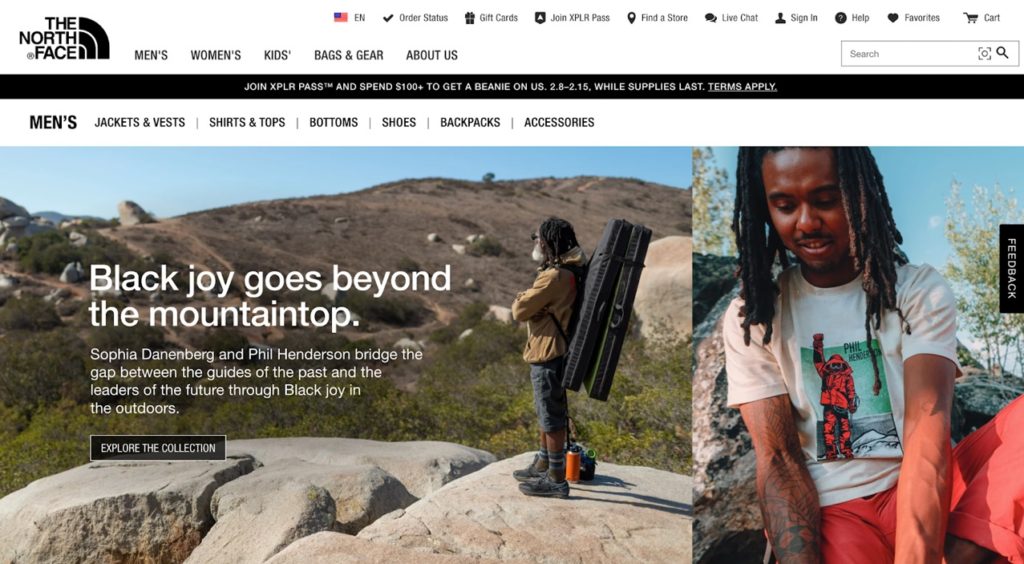
| Tip: Avoid using images or videos provided by the manufacturer or found on stocks. Use them only when it is impossible to take your own high-quality pictures. |
Another critical point is the file size. It will negatively affect page loading speed and overall SEO performance if it is too large. To prevent this, use image compression tools: plugins or websites like TinyPNG. They reduce an image’s size without diminishing its quality.
Add alt text with target keywords to your image to boost page performance. Alt text is different from the file name and is essential for image SEO. Search engines use alt text to understand what is in the picture. So make sure to add a short, clear image description and include keywords. But don’t stuff in too many keywords or use unnatural language—Google doesn’t appreciate this approach.
Use Structured Data Markup
Schema structured data markup is a set of HTML tags that help search robots correctly understand the content of a page. It’s a great way to enhance your snippet in the SERPs and increase the click-through rate. When the product schema is configured correctly, Google can display data about ratings, reviews, availability, and price directly in the snippet, making it more attractive for users.

| Tip: Make sure markup is configured correctly, and the page is accessible to robots. Structured data types must have properties supported by search engines and should match the overall context of the page. Ensure no harmful restrictions in the robots.txt file or HTML code (noindex meta tag). To check your structured data, run Google’s Rich Result Test. |
Also, make sure the information is updated and the markup doesn’t mislead users—don’t post spam or include content that’s prohibited by law.
Encourage Product Reviews and Share Testimonials
Product reviews are essential for e-commerce websites. Not only do they serve as social proof for your products and help your customers, but they also are beneficial for SEO. Customer reviews are considered user-generated content—an important ranking factor for Google. Besides, they may include some valuable keywords.
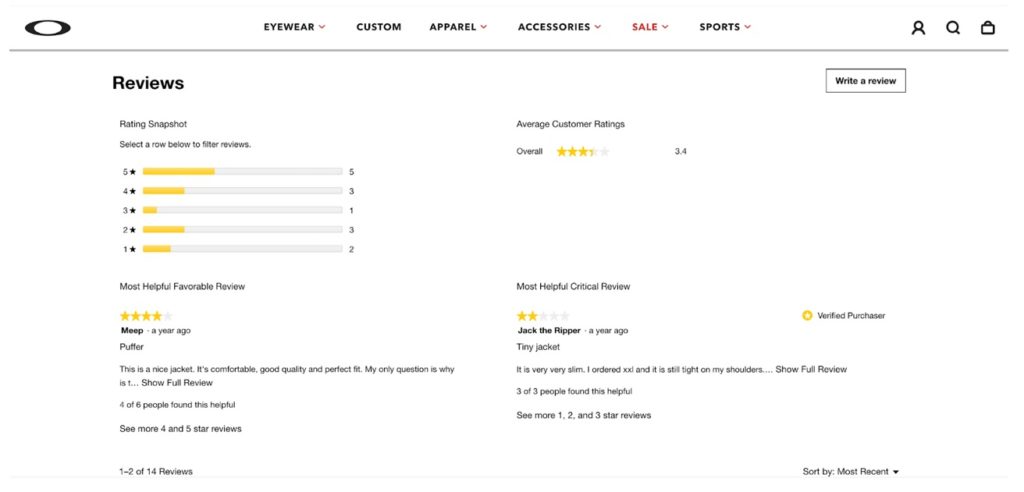
You should always encourage customers to ask questions, leave comments, provide reviews, and even add photos. There are a few ways to add product reviews. You can develop a custom page element or use a dedicated plugin, which is useful for user experience and can positively affect conversion rates.
| Tip: If your business has a physical location, don’t forget to connect a Google Business Profile to your website. Listing your business and getting reviews on Google can boost your product page rankings and add valuable information to your snippet. |
Use Internal Linking and Backlinks
Another important thing you can do to improve user experience and website SEO is to enhance the site structure and utilize internal linking on the product pages. For example, you probably noticed that most e-commerce sites feature the “Similar products” or “You may also like” sections at the bottom of the page. This encourages page visitors to explore other products, which leads to cross-selling and additional purchases. Internal linking also helps search engines crawl your website more efficiently and better understand its hierarchy.
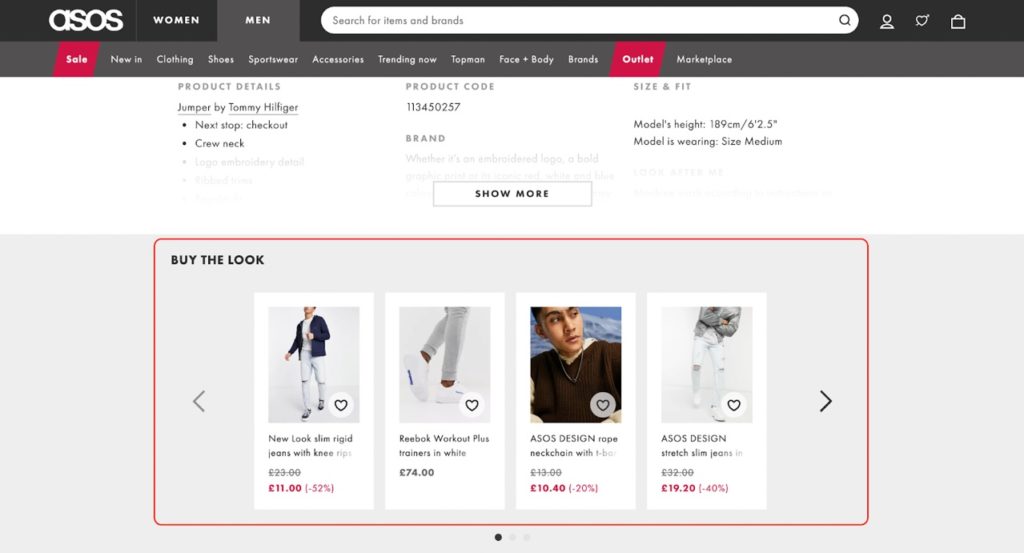
The breadcrumb menu works the same way—it makes your site more user- and SEO-friendly. Users can easily understand the site’s hierarchy and quickly go to a higher-level category or home page. To make the most out of breadcrumbs, don’t forget to mark them up with structured data. This allows you to include your hierarchy into the URL in a search snippet, which may increase the CTR.
| Tip: Don’t let product pages become orphans. This happens when their parent category is removed and they drop out of the site structure. Pages without internal links pointing to them can seriously harm rankings and, in some cases, even result in deindexing. |
Another great idea is to expand your backlink profile. Backlinks are links on other websites that lead to your site. They are crucial for SEO—the more links from reliable and authoritative sites you have, the higher your website can rank in search engines. Reach out to trustworthy media, reviewers, bloggers, or influencers and arrange for a publication of materials with links to your website.
Ensure a Great Page Experience and Fast Load
Page loading speed is a critical ranking factor, especially after the Page Experience update and the introduction of Core Web Vitals. Moreover, pages with a slow loading speed have a significantly higher bounce rate.
Here is what you can do to improve your page experience and increase loading speed:
- Carefully select a hosting provider. Often the hosting is the primary reason behind slow loading websites. If your website works worldwide, you can try using a Content Delivery Network (CDN) and distribute the hosting of your content across several locations around the world.
- Optimize media on the page. We have mentioned this before—large assets can significantly increase the page loading time. Compress images and videos to decrease their size.
- Use lazy loading. Lazy loading technology allows for loading assets gradually as users scroll the page instead of loading everything simultaneously. This helps reduce the initial loading time.
- Enable browser caching. Caching prevents the server from sending new requests to the database every time the page is loaded, using a pre-rendered HTML document instead, which decreases the loading time.
| Tip: If you use an adjustable CMS platform like Shopify or WordPress with a Woocommerce plugin, don’t hesitate to try different templates and plugins and find the ones that work best. This can help you reduce the page load time and bounce rate. |
Key takeaway: keep user experience in mind. Make sure your product pages are well structured, easy to understand and use, and have all the necessary elements that make online shopping easy and comfortable.
Six Steps Towards Successful SEO for Product Pages with SE Ranking
At this point, you know the basics of managing the SEO for your product pages. Now let’s dive deeper into advanced tips on how you can take your e-commerce SEO to the next level. We’ll be using SE Ranking—an all-in-one online SEO software that offers over 30 tools for every SEO task: keyword rank tracker, competitive and keyword research, website audit, etc. The platform provides analytical data and monitoring features that help specialists, agencies, marketers, and business owners bring their websites to the top of the search engine result pages and stay there.
Conduct Keyword Research
We have already mentioned that selecting the correct keywords for product pages can make a huge difference. But where do you find them? Luckily, SE Ranking has a useful Keyword Suggestion tool that allows you to create a list of keywords for all your product pages.
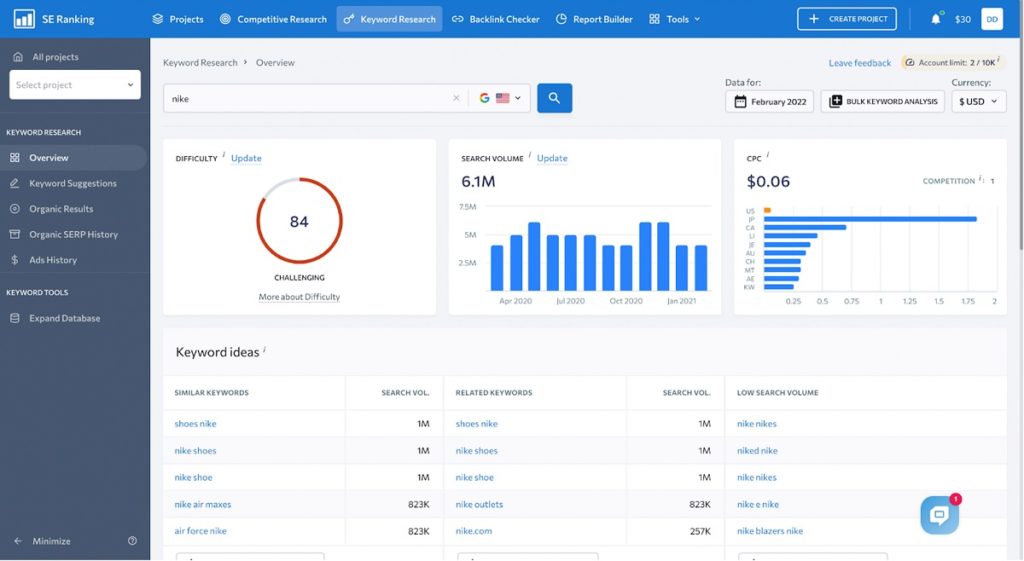
With Keyword Research, you can find relevant keywords and add them to your content. Diversifying your website semantics, comparing it with competitors, and filling in keyword gaps can help your pages rank higher in search engines. Also, you can find long-tail keywords for page headings and detailed product descriptions. It is recommended to have one focus keyword and a couple of associated queries for each page. After that, you can track their performance using the Rank Tracker tool. This will help you understand which keywords work best for your pages, and then you can make appropriate updates to improve search performance.
Check Your Competitors
Analyzing competitors is essential if you want your website to succeed. SE Ranking’s Competitor Research will help you keep a close eye on your rivals’ top organic traffic pages and identify your keyword gaps—you can expand your own semantic core keyword list and avoid missing keyword opportunities on your website page. You can also easily examine the structure of competitors’ pages and their features. It will be useful to look into the historical data of competitor domains to understand their strategies and uncover what pages they have been actively promoting. With this tool, you can also get insights into competitors’ backlinks built into the product pages.
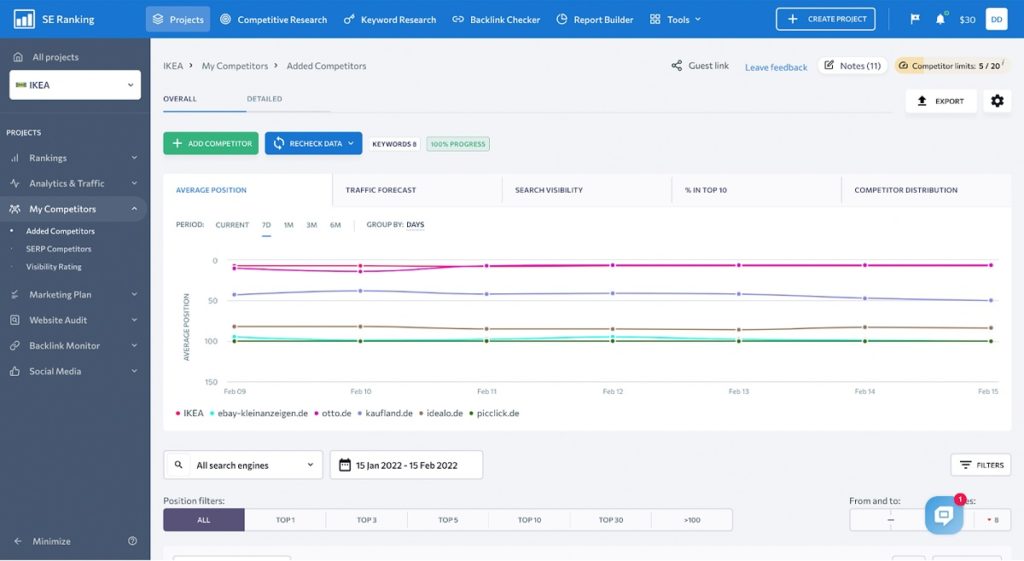
Create Separate XML Sitemaps
An XML sitemap is a file with a list of links to all of the pages on the website that Google should pay attention to. It is used to help search bots crawl the website more efficiently and quickly, which is extremely useful for large e-commerce websites with thousands of product pages. In other words, when a product page is included in your sitemap, a search engine can easily find and index it. As a result, online shoppers will be able to find it in search.
With SE Ranking’s Website Audit, you can easily create an XML sitemap to let search bots know about pages that need to be crawled and indexed. Make sure only to include pages with 200 HTTP status codes and pages that do not contain nofollow or noindex meta tags in this file. You can also add information about their update frequency and crawling priority. After that, you need to download the generated file, put it in the root folder on your website, and submit it through Google Search Console.
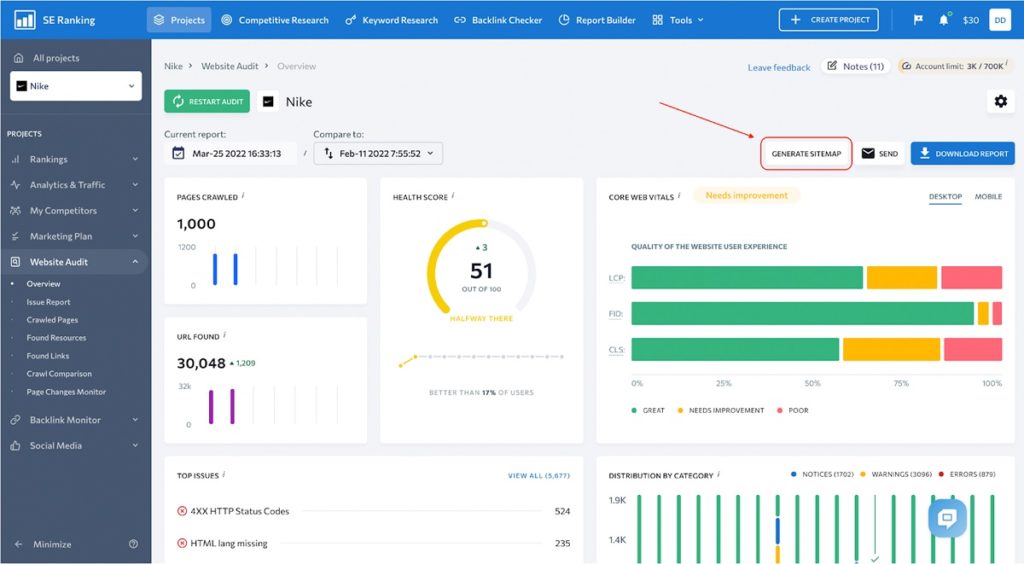
| Tip: Keep in mind that your file must be no larger than 50 Mb or 50,000 URLs. Otherwise, Google may not accept the sitemap. It is a good practice to create a separate XML sitemap for product pages or even for each product category if you have a large website. |
Fix Technical Issues
You need to fix technical issues that may prevent your pages from indexing or cause a decline in search positions. A solution is to run a complete website audit to analyze website optimization for search engines. The Website Audit from SE Ranking scans all (or specific) pages on the website and notifies you about important issues that affect SEO performance and need your immediate attention. The audit report shows the website's overall health score, identifies major problems, and suggests improvements. It will help you check a website for
- Security and crawling issues: page indexing and HTTP status, problems with a sitemap or robots.txt file, redirects
- Issues with content: duplicated content, optimization of page elements, including title and description tags, headings
- Linking problems: broken links, orphan pages
- Page experience score: Core Web Vitals results, mobile optimization issues
It is also necessary to make sure each page is optimized for a focus keyword and its long-tail variation. To check this, go to the Crawled Pages report, download the list, and then carefully analyze whether your main page elements are optimized.
Check for Cannibalization Issues
Imagine your site offers a product in different sizes or colors. In this case, creating product pages for every variation would be extremely tedious. Such pages would not only contain the same content—they would also compete in the search results against each other. This issue is called cannibalization. Search engines might even consider these pages duplicates, excluding them from search results, and the website's overall SEO performance might suffer. And sometimes, one product may appear in different categories—should you create identical pages for all of them?
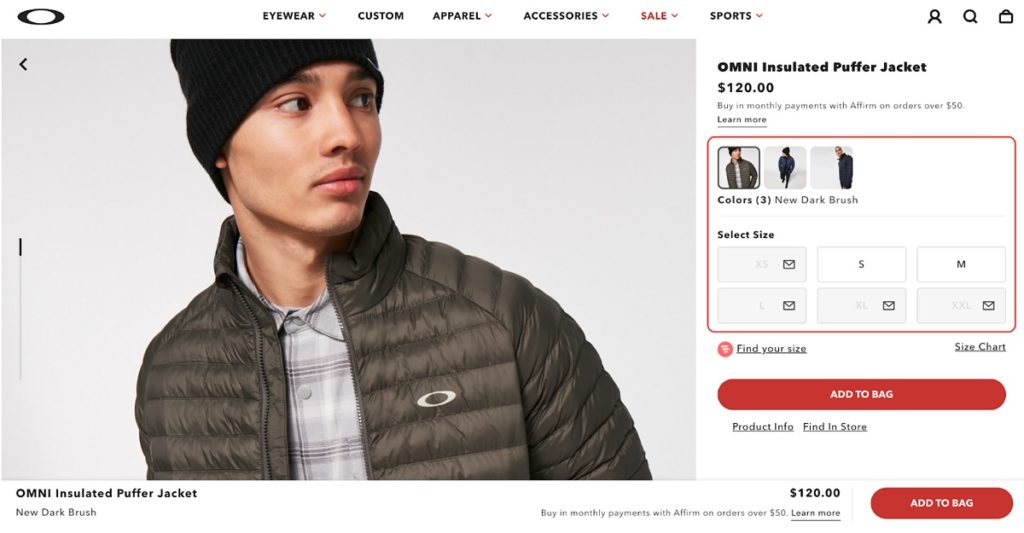
The solution is canonicalization. Here is how it works: you add a self-referencing canonical URL to the page, which will work as the main variant, and point other similar pages to it. This will tell search engines that only a certain page (usually with the best ranking and traffic) needs to be used for indexing and ranking. Use SE Ranking’s Rank Tracker to figure out pages that rank for the same keyword.
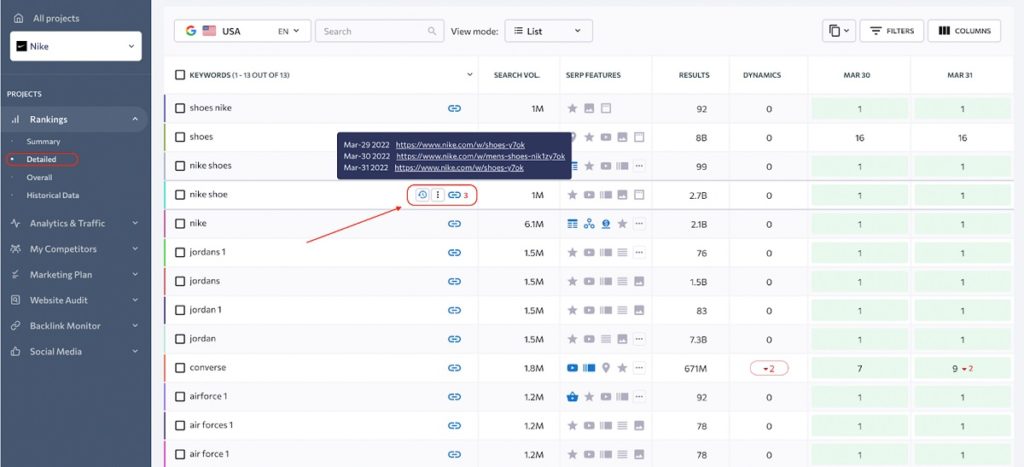
Then mark one of them as canonical using the <link> tag with the rel=”canonical” attribute and link other identical pages to it. When it comes to e-commerce, this solution is good for filtering and pagination pages, which usually cause a massive issue with cannibalization and generate tons of pages with duplicate content. However, when cannibalized pages are product and category pages, you may want to leave them without canonicalization.
| Tip: Do not include non-canonical pages in your sitemap. |
Monitor Changes
If you have read all the tips carefully and finally made a perfect product page, there is only one thing left to do—constantly monitor it. Your website is dynamic, so there might be changes that you’re not aware of. For example, some high-value keywords may have gone missing or the page description may have been accidentally deleted.
SE Ranking offers a Page Changes Monitor tool that keeps an eye on content, meta tags, index status, links, etc., and instantly notifies you when a change is detected. So if, for example, certain keywords or page elements have been removed by mistake, you can eliminate this issue before it affects your search rankings.
Summary
Now, you have everything you need to know about managing product page SEO. Summing up, let’s remember the most important tips:
- Choose keywords carefully
- Accurately plan your website structure
- Pay attention to major page elements: title, heading, meta-description, URL, etc.
- Work on unique and compelling product descriptions
- Use high-quality images and videos
- Keep a close eye on competitors for new ideas and keywords
- Regularly monitor changes and fix technical issues
E-commerce is a very dynamic industry, so make sure to always stay up to date with trends and competitors. Even though product page SEO may seem easy, it requires lots of effort. But rest assured, it is worth it. Don’t hesitate to take action and compete for higher SERP positions and, consequently, more leads.
About the Author
Alyse Falk is a freelance writer with experience in digital marketing, technologies, content marketing, marketing trends, and branding strategies. Alyse also writes for several reputable sites where she shares her hints for creating content. You can reach her at [email protected].
Related Information
Best WooCommerce Shipping Plugins
8 Best Photography Plugins for WooCommerce
Best WooCommerce Multilingual Plugins
WooCommerce How to Add Products
Advanced Order Export for WooCommerce
